Full Length Research Paper
ABSTRACT
The study assessed the roles of community members on community level waste disposal in the city of Lilongwe in Malawi. The communities are basically low income and densely populated where a lot of people depend on small scale businesses. The study used a mixed methods approach. The target population was the community members of eighteen years of age and above. The sample size was 40 and the participants were selected using simple random sampling. Likert scale was used which helped in weighing forty questionnaires which were administered to the respondents. The data collected was analyzed using content analysis and statistical package for social science (SPSS). The results from the study show that community members of Lilongwe City have to work together and embrace different effective skills in mitigating poor waste disposal. In total 63% of the respondents indicated that the community lacked waste management skills while 93% of the respondents stated that an increase in the population leads to an increase in the waste produced in the communities accordingly. A total of 65% indicated that members of the community were not willing to pay for waste management in their areas while 70% attributed the waste management responsibility to the government. The study recommends that the stakeholders should plan for awareness programs; community members should identify their capabilities to turn waste into briquettes which they can use for cooking and selling to generate income; the government should provide loans to disadvantaged communities for small scale businesses in waste re-cycling and that the government should provide free waste collection services to the underprivileged urban communities.
Key words: Waste, disposal, communities, garbage.
INTRODUCTION
According to Swedberg (2014), disposal is process of managing and getting rid of products that turn into trash or garbage. Wastes can be solid, liquid and gas. These wastes are disposed or managed in different ways like; some burn the wastes, some construct pit holes and dispose them in the pit holes, others dump the wastes in water resources.
The world has been affected by the poor waste disposal and management. Due to the problem, Chavez (2009) and Damian (2017) indicated waste generation rates are rising and in 2009 the world’s cities generated 2.01 billion tons of solid wastes, resulting to a footprint of 0.74 kg/person a day. The study adds that, with rapid population growth and urbanization, the annual waste generation is expected to increase by 75% from levels of 3.40 billion tons in 2050. Compared to those in developed nations, residents in developing countries especially the urban poor are more severely impacted by unsustainably managed wastes. In low-income countries, over 90% of waste is often disposed in unregulated dumps or openly burned, which results to serious health, safety and environmental problems. Poorly managed wastes serve as breeding ground of vectors, contributing to global climate change.
Khonje (2012) conducted a pilot study on the case of Malawi, more especially in the city of Lilongwe. The city is one of the largest cities in the country with a population of 670,000 growing at a rate of 4.3 per year. With the increase in population in Lilongwe, the rate of wastes also is increasing. A study done by the Monitoring and Evaluation Office of Community Servings (2010) indicates that the city generates 109 tons of solid wastes per day; a total of 15% is derived from industries, 25% from commercial areas, 20% from hospitals and 40% from residential areas. The study indicates that the city has been hit by a sanitation problem in both solid and liquid waste management. Waste disposal has also affected many Malawian urban communities around Lilongwe City. People of the communities also have their own ways of dumping wastes, for instance some use pit latrines and others dispose the wastes in water sources found in the communities like, streams, dams and roadsides.
Problem statement
Lilongwe as a capital city of Malawi is made up of the communities which are highly affected by poor waste disposal. People dump wastes without considering the health hazards, for instance, some dump the wastes in water sources. Wastes like diapers are commonly dumped in streams, swamps and rivers near the community. The end result of this improper waste disposal has led to the communities in the city being un-hygienic. People suffer from both water borne and vector borne diseases. These diseases make a lot of people fail to focus on productive activities which could help them generate income, since some are busy taking care of the patients suffering from these diseases whilst others are becoming victims of water and vector borne diseases. Therefore, the study aims at assessing roles of community members on community level waste disposal in Lilongwe City.
Overall objective
The overall objective of the study is to assess the roles of community members on community level waste disposal in Lilongwe City in Malawi.
Specific objectives
(a) To identify the causes of poor waste disposal in the communities of Lilongwe City.
(b) To assess the community perception towards poor waste disposal in Lilongwe City.
(c) To assess how poor wastes disposal affects the communities in Lilongwe City.
(d) To identify the roles of community members in mitigating the poor waste disposal in Lilongwe City
LITERATURE REVIEW
Causes of poor waste disposal in the community
Barre (2014) in her study titled ‘Waste Market in Urban Malawi’ indicated that most community members lack waste management skills. This is to say that most of the people in Malawian society do not know waste management skills such as reduce, reuse and recycle. For example, most of the plastic bottles are recyclable materials, but most people in Malawi do not have the skills on how they can recycle the bottles and, in the end, they throw the bottles irresponsibly, thereby putting more communities at risk due to improper management of the wastes.
A study done by the National Statistic Office of Republic of Malawi (2008), proved that since the overall level of waste production is positively correlated with the population of country, an increase in population automatically implies an increase in the amount of overall waste. There are official waste disposal sites that people may use to get rid of the large amounts of waste. However, there is a small but still significant amount of people who just dump their trash illegally in the woods and water sources. This problem is increasing with an increase in population since more waste is produced, and thus the probability for more waste dumping is likely to increase.
Most of the people avoid paying fees at waste management sites. Busa (2009) supports this claim more especially in cases of residents. In various parts of communities, disposing wastes illegally is on the rise. This habit is associated with the avoidance of paying disposal fees at waste management sites. The people who engage in such acts are of the opinion that the prevailing waste collection fees are excessive. Therefore, instead of following the rightful channels for disposing waste or paying third party waste pick up services, they illegally dispose the waste in remote locations. Some third-party waste pick-up services have also gotten into the habit of dumping waste on illegal dumpsites to avoid paying the disposal fees.
Busa (2009) suggested that poor waste disposal is caused by ignorance, where most people do not understand and are not very much aware of the consequences of poor dumping. Busa (2009) argued that regardless, some individuals simply do not see the need for recycling waste or follow the proper waste disposal channel and therefore go to highly unusual lengths to dispose waste illegally. Some people are simply too lazy to bring their trash to official dumping sites. A fraction of the society also does not care about the poor dumping problem and its consequences. They do so by completely avoiding prosecution and detection, which means that they do know the act, is unlawful. As a matter of fact, most of the items illegally disposed of, such as old appliances, white goods and furniture can be easily recycled or even reused. So, it can be suggested that most of the people engaging in acts of poor waste disposal simply do not understand the importance of reuse or the concept of recycling wastes.
Community’s perception towards poor waste disposal
Poor waste disposal is often regarded as a minor issue by many people; hence, Trevor (2017) concluded that this is due to social norms a particular community may possess. Humans are known to be influenced quite a lot by the people they mostly interact with. Some community members consider poor waste disposal as not a big deal or they actively contribute to it. They are also more likely to see it as an appropriate method of getting rid of trash. Thus, social norms and the behavior of close people play an essential role in how likely people are to accept or reject the idea of poor waste.
Neidell et al. (2019) argue that people in the community believe that dumping of wastes improperly is the only way of making the soil fertile. Carlsess (2007) also adds some people are of the idea that wastes make the soil fertile and large piles of wastes are dumped on land to make the soil fertile. On the same note, some are of the view that dumping wastes anyhow creates manure, hence, most of the community people dump wastes poorly to obtain large amount of manure more especially compost manure for their fields.
Lilongwe City Council (2015) is of the view that people believe that, it is the government’s duty to take care of the disposed wastes. They dispose wastes poorly hoping that the government will one day appear to clean up the large piles of wastes. For instance, this is the case with most Malawian urban markets where the market users dump large piles of wastes on land or on the dumping site, hoping that the government through the city council will come and clean up the mess.
Williams et al. (2017) in an article titled ‘Preliminary study of wastes management’ suggested that, people believe that waste disposal is something they do not have control over and that it is only nature that has control over the wastes, hence, they dispose wastes freely, believing that nature will do the controlling or the mitigation of the wastes for instance, the case with diapers. Many people dispose them in swamps, streams, rivers and wells because they believe managing them is out of their hands, so they leave it in the hands of nature to do the magic. That is why we see a lot of diapers in water sources waiting to be washed away by running rain water in the rainy season.
Effects of poor waste disposal at the community
Williams (2005) in his study titled ‘waste treatment and disposal’’ adds that soil contamination plays a bigger role in affecting the community. Ideally it is people’s desire that plastic, glass, metal and paper waste end up at a recycling facility. It then returns to the people as a renewable product. But the reality is entirely different. Contamination occurs by spilling and burying hazardous components in the soil. For example, when a plastic water bottle is incorrectly sent to a landfill, or left, at any other place, to be absorbed by the soil: plastic water bottles eventually break down to release a harmful component called, DIETHYLHYDROXYLAMINE (DEHA), a carcinogen which hurts the reproductive capabilities, causes liver dysfunction and weight loss issues. DEHA seeps into the surrounding areas of the soil and water bodies to harm the animal and plant life which depends on it. If the soil is contaminated with the DEHA component it means people’s farm lands will be affected too.
Moreover, water contamination has proved to have a significant effect to the community. Kaseva (2004) and Abdoli (2020) concluded that, when wastes are disposed into water bodies, they are often dissolved by the water bodies, which in turn end up forming poisonous substances that may be harmful to living organisms including humans. This is also harmful to people’s domestic activities especially those who use the water sources for cooking, washing and drinking. If the water is contaminated, the community can fail to use the water for domestic purposes.
Poor waste disposal impacts the climate in various ways. According to Beal (2012) and Brigham (2018), poor waste disposal disturbs the climate. When the wastes are disposed off improperly, they form harmful greenhouse gases which are created from decomposing waste. These rise up to the atmosphere and trap heat and adversely cause extreme weather reactions in the form of storms and typhoons. He also adds that the level of precipitation in the air can be destructed which in the end leads to acidic rains to severe hail storms and global warming.
According to Giusti (2009), poor waste disposal has an impact on human health. Salman (2021) states that when wastes are dumped everywhere either on land or water sources, this in turn creates a health hazard to people nearing the site where the wastes are dumped. For instance, wastes dumped in water sources can create a breeding ground for mosquitos and in the end, people living near the water source may suffer from malaria and other water borne diseases like cholera. Additionally, when people come in contact with waste, it causes skin irritation and blood infections. People also contract diseases from flies which are carriers of illnesses after breeding on solid waste.
Roles played by community members in mitigating poor waste disposal in the community
Although poor waste disposal brings negative impact to the community, there are still some roles which community members can take up to mitigate the problem. According to Blantyre City Council (2013), organizing activities based on community clean up days can help to mitigate poor waste disposal. Community leaders can mobilize volunteer groups for each clean-up initiative and organize special clean-up days in which all members of the community participate twice a year or more often if possible. The council also indicated that clean up days have proven to be a tremendous initiative in the sense that people take full responsibility of their community and to dump wastes poorly becomes difficult, clean up days help to save resources where government financial resources like money is saved, which could be used to employ people to clean up the wastes, but the coming in of community members to clean up their own community stops the burden of losing money by the government through the city councils.
The problem of poor waste disposal basically is the process which involves people committing the act, so to stop the act the community members also have responsibility in reporting of illegal dumping. Wilson (2007) argued that it is possible for people in all communities and societies to stand up against poor waste dumping. The people that engage in poor waste dumping activities do so knowingly and are always on the lookout for places where the environmental regulatory authorities hardly patrol. Hence, if people can take the responsibility of reporting any witnessed act of illegal dumping, it can impressively help in curbing the activity. This strategy should also work towards establishing a special task force that includes the environmental, health, police, and public works departments to work in cooperation with the local people.
Study by Anjum (2013), towards the mitigation of poor waste disposal, stated that wastes can be managed if the environmental authorities, together with the local community chiefs, set lower disposal fees to encourage people to use the lawfully stipulated waste disposal systems. At the same time, the relevant regulatory bodies against poor dumping must set higher fines to discourage the habit. This can be done by re-defining the fines and punishments for poor dumping as well as the licensing and charge rates for dumping services. For instance, it has been cited that in some areas, it may be less costly to illegally dump and pay a fine than using legitimate waste disposal channels. By employing this strategy, societies can become less vulnerable to poor dumping of wastes.
A report produced by UNEP (2015), suggested that members of the community should be in a position to embrace the practice of Reducing, Recycling, Reusing (The 3R). Alexis and Mihelcic (2009) note that poor waste dumping is a result of a high level of overall waste production. The amount of waste generated can be reduced, then the outcome will be fewer, and there will be fewer scenarios of poor dumping of wastes. All people should always strive to reduce the amount of waste they generate by only purchasing and using essential products. Also, the promotion of recycling initiatives such as the opening up of various designated areas for free collection of used and obsolete appliances, furniture and other home products for recycling can reduce poor dumping. The practice of reusing, such as donating or selling used products that are still in good condition, should as well be encouraged to cut back on poor disposal of appliances, white goods and furniture.
RESEARCH METHODOLOGY
The study used a descriptive research design which involved describing the events pertaining to community level waste disposal. The study used the mixed methods of research. This enabled the researchers to collect data and explain the phenomena more deeply and exhaustively. This was made possible because much information was gathered from respondents. The study employed quantitative design because it helped the researcher to come up with questionnaires which easily made quantifiable presentation of quantitative data. The research was conducted in Lilongwe City in Malawi.
Study population
The study population targeted people of ages ranging from 18 years and above. In total 40 participants were sampled for the study.
Sampling techniques
The study adopted simple random sampling because in random sampling, every person has an equal chance of being selected or picked in a sample. Taherdoost (2016) pin pointed that this sampling technique is used when the elements of population are spread over a wide geographical area. The population was divided into sub-groups called clusters on the basis of their geographical location.
Sample size
A total of 40 participants were sampled for the study and given questionnaires to complete. All the 40 participants responded to the questionnaires.
RESULTS AND DISCUSSION
Response rate
The study achieved a 100% response rate.
Gender of respondents
Gender was included in the research study because it is the only way of addressing gender imbalance in a country like Malawi, hence, the study gave room to both type of gender to avoid gender imbalance as indicated in Table 1.

Among 40 participants, 23 were females who participated in the research and 17 were males. This represents 57.5% for the females and 42.5% for the males, respectively. According to the results, it has clearly shown that more females responded to the questionnaires.
Age of respondents
Age is an important aspect to consider in research because it helps the researcher to learn different knowledge and ideas from different age groups.
The age range of the respondents was divided into 18-23, 24-29, 30-35, 36-41 and 41 above. From Table 2, the researcher can conclude that 18-23 recorded the highest number of respondents which represents 42.5%; this also gives a clear reflection that more participants were youths in the age range of 18-23.
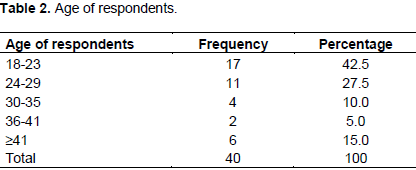
Marital status of respondents
Marital status involves distinct relationships among people. It is imperative to consider marital status in research because it helps the researcher determine how different relationships view things around them.
The Figure 1 shows marital status of respondents which were grouped into single, married, divorced and widowed, hence the results show that, 27 participants were single, 8 were married, and 3 participants were widowed and 2 were divorced. This proves that more participants were single.

To identify what causes poor waste disposal in the communities of Lilongwe City
Most of the community members lack waste management skills
Figure 2 indicates that most of the community members lack waste management skills in the city.
According to Figure 2, a total of 63% of respondents strongly agreed to the statement, 35% agreed to the statement and only 2% of the respondents were not sure about the statement. Based on the results, it has given a clear proof that indeed most community members lack waste management skills. Harrison (2013) argues that most community members lack waste management skills like reducing, reusing and recycling, these skills are not known by community members because they are not trained on how to use them, as a result the people end up dumping the wastes poorly.
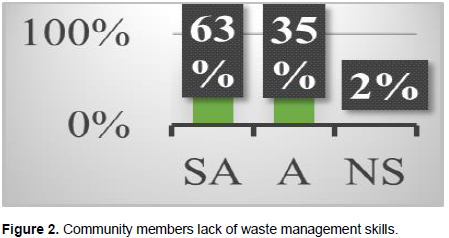
Increase in population which implies an increase in the amount of wastes to the community
The study sought to establish the effect of the increase in the population on the volume of waste generated by the communities in Lilongwe City. The results are tabulated in Table 3.

Out of 40 participants 55% strongly agreed, 37.5% agreed, 5% were not sure and 2.5% disagreed to the statement. From the presentation, it gives a clear indication that indeed increase in population also implies an increase in the amounts of waste produced in the community. This is so because most of the respondents strongly agreed to the statement than those who disagreed to the statement. Assa (2018) argues that high population has a very big impact on the community in the sense that as the community is ever increasing, the demand for necessities also increases and some of these necessities need to be dumped after use and because of increase in population the demand for the dumping sites also become high and end up being filled up and the end result is that, people start to dump wastes recklessly. For instance, in India, parts of Gurugram are highly populated and due to high population, the level of poor waste disposal has also increased.
Most of the people avoid paying fees at waste management sites
The study established that most people in the communities are not willing to pay for waste management services in Lilongwe City. The results are indicated in Figure 3.
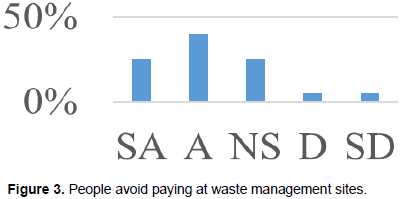
Figure 3 demonstrates that, 40% of participants agreed, 25% of participants strongly agreed, 25% of participants were not sure about the statement, 5% disagreed and also 5% of the participants strongly disagreed. Based on the response from the participants it has shown that most of them were in favor of the statement. This arguably means that indeed most people avoid paying fees at waste management sites. Report done by Liongwe Water Board (2009), supports the statement that, most people avoid paying fees at wastes management sites because the fee rates are high which fails to give room to people, who are less privileged and such kind of people end up dumping the wastes poorly. For example, people have to pay 3500.00 kwacha per month for their wastes to be dumped at waste management site, but this case only favors people who are more privileged and the less privileged who always live on the same 3500.00 kwacha per day have nowhere to dump the wastes and hence ending up dumping the wastes anyhow.
Community members are ignorant, hence this contributes to poor waste disposal
It was further established that the ignorance of the communities in waste management led to poor waste disposal in Lilongwe City as shown in Figure 4.
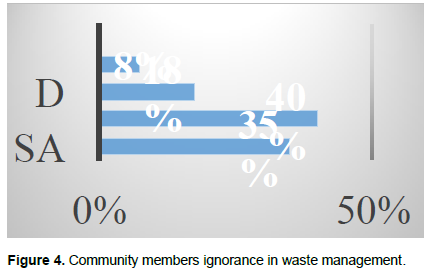
Figure 4 proves that more of the participants are in favor of the statement which states that most community members are ignorant. Teka (2006) states that most of the people are illiterate, hence, they lack knowledge. Due to this reason, they see no problem in dumping wastes poorly; hence if level of people who lack knowledge about wastes is high, it simply means the overall amount of wastes in the community can also increase, this also shows that out of 100% of the response rate, 40% agreed, 35% strongly agreed, 18% disagreed and 8% strongly disagreed to the statement. The results for objective one which was to identify what causes poor waste disposal in the communities of Lilongwe City are summarized in Table 4.

Statements in objective 1, which was the causes of poor waste disposal in the communities in Lilongwe City were all answered by the respondents and this basically provided a 100% of the response rate. Statements like most community members lack waste management skills, increase in population which implies an increase in the amounts of wastes to the community, most people avoid paying fees at wastes management sites and community members are ignorant hence contributing to poor wastes disposal shows the highest degree of strongly agree and agree. This means that statements like these are really the causes of poor wastes disposal to the community and it is imperative that community members become aware of the causes in order for them to avoid practicing these poor habits (Figure 6).
People’s perception towards waste disposal in Lilongwe City
The study sought to establish the community member’s perceptions towards waste disposal in the city as shown in the Figure 5.
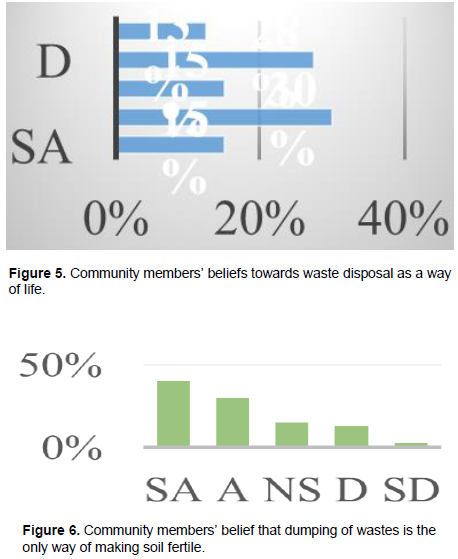
The results indicate that 30% of the respondents agreed to the statement, 28% disagreed to the statement, 15% strongly agreed to the statement, 15% was not sure about the statement and 13% strongly disagreed to the statement. To support this statement, environmental behaviorist concluded that behavior is something that can be passed from person to person, the same applies to issues to deal with wastes disposal. The idea of dumping wastes poorly can be passed on from generation to generation, it is imperative that we check our behavior when it comes to waste disposal so that the future generations may emulate proper habits of dumping wastes.
People in the community believe that dumping of wastes is the only way of making soil fertile
Figure 6 shows the results of the community members’ belief that the dumping of waste is one way of making the soil fertile.
The presentation clearly shows that most of the respondents strongly agreed to the statement with 40% strongly agreeing. Seconded by agree with 30% of respondents agreeing to the statement, 15% of respondents were not sure about the statement while 13% of the respondents disagreed to the statement whereas only 3% of the respondent strongly disagreed to the statement. From the results we can prove that indeed people believe that dumping of wastes is one way of making soil fertile. Alexis and Mihelcic (2009) gave evidence that people of the community believe that wastes make the soil fertile and these beliefs are much common in rural communities where most people dispose large piles of wastes to obtain manure.
People believe that it is the government duty to take care for the disposed wastes
Figure 7 shows the study results on the community members’ belief that it is the duty of government including local government to take care of waste management.

The statement aimed at proving if people believe that, it is the government’s duty to take care of the disposed wastes, from the graphical presentation, it has been shown that 40% of the participants agreed, 30% strongly agreed, 10% were not sure about the statement, 10% disagreed and 10% strongly disagreed to the statement. Based on the results we can prove that most people of the community members do believe that it is the government duty to take care of the disposed wastes.
Lilongwe Water Board (2009) added that, the statement usually applies to most Malawian communities, where the community members have the tendency of leaving everything to the government to sort things out. In short, this attitude simply indicates that most community members do not want to take responsibility for their own mess.
Community members’ belief that disposal is something they do not have control over; it is only nature that has control over wastes
Figure 8 shows the results of the community members’ belief that they have no control over waste management and that this must be left to nature.
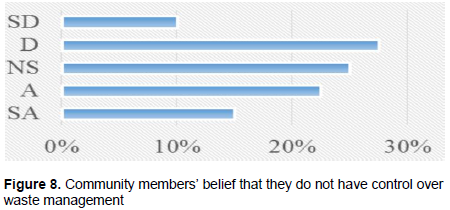
According to the results, many of the participants were in disagreement to the statement that people believe that waste disposal is something they do not have control over, it is only nature that controls wastes, some were not sure about the statement, others agreed while others strongly agreed and others strongly disagreed. This shows the percentage how the participants viewed the statement. From the presentation, 28% represents the participants who disagreed, 25% were not sure about the statement, 22% agreed to the statement, 15% strongly agreed, while 10% gives out the participants who strongly disagreed to the statement. Christopherson (2003) indicated that people believe that nature, like water source have the ability to control wastes, a good example can be industries. They dispose wastes in water sources like streams, swamps, rivers and lakes; they usually do this hoping that water bodies will get rid of the wastes. The results for objective two which to assess the community’s perception towards waste disposal in Lilongwe City are summarized in Table 5

Objective 2 has proven that people do have different perceptions towards wastes. This is based on how respondents viewed the statements in this objective, so from the results 49% agreed, 40% strongly agreed, 31% disagree, 26% were not sure while 14% strongly disagreed.
Effects of poor waste disposal on the communities in Lilongwe City
The following were found to be the effects of poor waste disposal on the communities in Lilongwe City.
Soil contamination plays a bigger role in affecting people’s farmlands
Figure 9 shows that soil contamination plays a bigger role in affecting the community members’ farmland in the city. It shows that, 50% of the respondents strongly agreed to the statement, 32% of the respondents agreed to the statement, 10% were not sure about the statement, 5% of the participants disagreed to the statement while only 3% of the respondent strongly disagreed to the statement. This clearly indicates that, indeed poor waste disposal contaminates the soil, thereby affecting people’s farmlands. Wastes pose a threat to the soil where in most cases community members depend on it for farming and hence this contributes to starvation whereby people can go days without food. Osuagwu (2018) gave examples of oil spills and plastic papers which can cause damage to the soil, which in turn have an impact on people who are into farming.
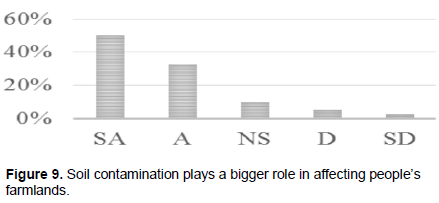
Community members fail to use water sources for domestic purposes because water sources are contaminated
Table 6 shows the results on the failure of the community members to use water sources for domestic purposes due to contamination.

In total, 50% of the respondents agreed to the statement, 42% of the respondents strongly agreed to the statement and 8% disagreed. From the results it shows that people fail to use water sources for domestic purposes because water sources are contaminated. In relation to study done by World Health Organization (2011) titled ‘guidelines for drinking quality water’’, proved that more water sources are contaminated due to human activities like poor disposal of wastes into water source and this in the end creates water insecurity among community members where sources of getting water for domestic purposes become scarce due to dumping of wastes into water sources.
Poor waste disposal disturbs the climate thereby affecting livelihood activities like farming
Table 7 shows community members’ views on the effect of poor waste disposal on climate and its effect on their livelihoods.

Table 7 indicates that all 40 respondents responded to the statement, where 16 strongly agreed, 13 agreed, 9 were not sure, 1 disagreed and 1 strongly disagreed to the statement. This proves that more people agree to the statement that, poor wastes disposal disturbs the climate thereby affecting livelihood activities like farming. To support this statement Malawi National Environment Action Plan of 1994 added that poor waste disposal contaminates, the ozone layer where a lot of it leaves people feeling hopeless as they feel unable to make necessary changes. For instance, some wastes are burned like paper and plastics which brings out gaseous chemicals, causing the chemicals to be released and accumulated into the air, hence in the end contribute to damaging the ozone layer and also hurt the surroundings. Besides, with chemicals such as dioxin out there, the air has been proven to have harmful effects on people and the environment.
People are impacted by various diseases which affect their health
Table 8 shows the respondents’ views on how community members are impacted by various diseases due to poor waste disposal.
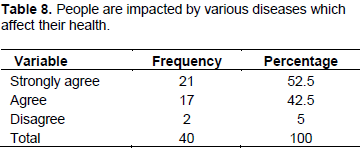
The presentation of results shows that strongly agree recorded the highest number of respondents with 52.5% strongly agreeing, seconded by agree with 42.5% respondents agreeing to the statement while disagree recorded the least number with 5% respondents disagreeing to the statement. This perfectly proves that poor waste disposal indeed impacts people with various diseases which affect their health. Beech et al. (2017) proved that wastes are breeding grounds of mosquitos and when large piles of wastes are being disposed, it means the level of mosquitos breeding also increases that is why more people in urban areas in Malawi are always suffering from malaria.
Table 9 shows that, the researcher shares the same view with the respondents, where most of the respondents agreed to the statements in objective 3 which states the effects of poor waste disposal in the community, strongly agree recorded highest number of respondents, seconded by agree. Because of the proof given, this is a true reflection that people really experience these effects when they practice poor waste disposal and management.

Roles played by community members in mitigating poor waste disposal in the communities in Lilongwe City
The following were determined by the study to be the roles played by the community members in mitigating poor waste disposal in the communities within Lilongwe City
Organizing activities which are based on community clean up days
Figure 10 indicates that, 55% of respondents strongly agreed, 36% agreed, 5% disagreed, 2.5% of the respondents were not sure and 2.5% strongly disagreed to the statement. To ensure that poor waste disposal is dealt with, communities can indeed come together and work towards improving their community through conducting special events like community clean-up days, this in turn helps to show how members of the community are accountable to their community and it can also help to instill a sense of responsibility among the members of the community.
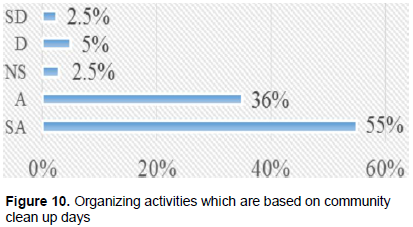
Reporting of illegal dumping
Based on the results in Figure 11, it indicates that, 50% of the participants agreed, 32% of the participants strongly agreed, 10% strongly disagreed, 5% were not sure and 3% of the participants disagreed to the statement of reporting illegal dumping. Environmental Management Council (2013) supported the statement by adding that members of the community can report individuals who are practicing illegal dumping to people who are custodians of rule of law like the police, local chiefs, and the elders of the community. With such kind of attitude, it can help the community members to desist from practicing improper dumping of wastes because they will fear that eyes are everywhere watching them and in turn, they can end up practicing appropriate means of dumping wastes.

Setting lower disposal fees to encourage people use the lawfully stipulated waste disposal systems
The results in Figure 12 indicate that the highest number of respondents agreed to the statement, with 38% of the respondents agreeing. 23% of the respondents were not sure about the statement, 20% of the respondents strongly agreed to the statement and 19% of the respondents disagreed to the statement, 8% of the respondents strongly disagreed to the statement.
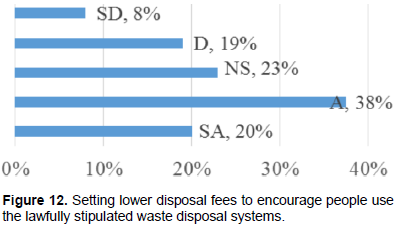
Holbrook (2011), indicated that most of the people dump wastes poorly because fees of garbage collectors are high and because the community members have no other means to dispose the wastes, they end up dumping wastes improperly, to be fair enough, it is imperative that these local garbage collectors set up lower disposal fees so that community members can have the chance to dispose the wastes to proper wastes management sites.
Embrace the practice of reduce, reuse and recycle waste
In total, 67.5% strongly agreed, 22.5% agreed, 7.5% disagreed and 2.5% was not sure about the statement of embracing the practice of reducing, reusing and recycling (Table 10). It can be concluded that embracing the practice of reduce, reuse and recycle is indeed an effective way which community members can use in mitigating poor waste disposal. It is imperative that community members start to embrace these three practices for they have been proven to be effective practices, for instance; these practices help to save space for landfills. Carless (2007) suggested that, instead of dumping the wastes at dumping sites, the community members can reuse the wastes to make new other products for instance members can reuse the wastes to make briquettes, which in turn can also be helpful in saving the environment, plastic bags can also be reused, instead of dumping plastic bags, people can reuse them as shopping bags when going out for shopping. The results of objective four which is to identify the roles played by community members in mitigating poor waste disposal in the communities in Lilongwe City are summarized in Table 11.

The results give a clear indication that people can apply the statements and use them to mitigate poor waste disposal in the community, this is so because the response proves that more respondents were in favor of the statements. In the end, if applied, they can be effective ways in mitigating poor waste disposal.
CONCLUSION
The research found that indeed more community members have a role to play in mitigating poor waste disposal in the community, for example in objective four which has statements like: embrace the practice of reduce, reuse and recycle has given a clear indication that, the community members need to truly embrace this practice as one of their roles in mitigating poor waste disposal, so based on this statement, 67.5% of respondent strongly agreed to the statement and 22.5% of respondents agreed to the statement, which gives a clear indication that indeed community members should be encouraged to embrace the practice of reducing, reusing and recycling as one way of mitigating poor waste disposal in the community. The data that has been provided can be used for awareness campaigns, where by community members can be given an awareness on the impact of practicing poor waste disposal so that they can take up mindset change, on issues to deal with wastes. It is imperative to the community members that as they are being made aware of their roles, capacity building areas can also be easily identified through the community members. For instance, awareness can be a tool whereby they can easily identify the skills which community members have. Instead of practicing poor wastes disposal, community members can use the skills to make various goods out of the wastes. The results of the study have given a clear picture that community members of Lilongwe City have a bigger role to play in mitigating poor waste disposal in their community. It is crucial that people of this community work hand in hand with other stakeholders to ensure that every member fulfills the role of trying to improve the community, so that the problem of vector and water borne diseases can also be mitigated once and for all.
RECOMMENDATIONS
(1) Stakeholders should plan for waste management awareness programs.
(2) Community members should identify their capabilities to turn waste into briquettes which they can use for cooking and selling to generate income.
(3) Government should provide loans to the communities for small scale waste recycling businesses.
(4) Government should provide free waste collection services to some underprivileged urban communities.
CONFLICT OF INTERESTS
The authors have not declared any conflict of interests.
REFERENCES
|
Abdoli (2020). RFDID Application in Municipal Solid Waste Management. International Journal of Environmental Research pp. 45-65. |
|
|
Alexis MA, Mihelcic JR (2009). Sustainable Recycling of Municipal solid waste in developing countries. Waste Management 29(2):915-923. |
|
|
Anjum R (2013). Willingness to Pay for Solid Waste Management: Case Study of Islamabad. Islamabad: Islamabad Pakistan Institute of Development Economics CEEC working paper No.3. Available at: |
|
|
Assa D (2018). Waste of a Nation: Garbage and Growth in India. Cambridge: Harvard University Press. |
|
|
Barre J (2014). Waste Market in Malawi. Lilongwe. Available at: |
|
|
Beal F (2012). Municipal Solid waste Recycling. (Doctoral dissertation). Available at: |
|
|
Beech E, Rivers M, Oldfield S, Smith PP (2017). Global Tree Search: The First Complete Global Data Base of Tree Species and Country Distributions. Journal of Sustainable Forestry pp. 454-489. |
|
|
Blantyre City Council (2013). Benefits of National Clean-up Day. Nyasa Times pp. 5-15. |
|
|
Busa R (2009). Solid Waste Management- A Model study. Sies Journal of Management pp. 24-99. |
|
|
Brigham K (2018). How San Fransisco Sends less Trash to the landfills than any other Major City. Available at: |
|
|
Carless J (2007). Taking ot the Trash. Island Press. Available at: |
|
|
Chavez D (2009). Solid Waste Management. Availabel at: |
|
|
Christopherson RW (2003). Geosystems: An Introduction to Physical Geography. Prentice Hall. |
|
|
Damian C (2017). Global Pollution Kills 9million a year and threatens survival of Human Society. The Guardian. |
|
|
Environmental Management Council (2013). Annual report. Broome County Environmental Management Council. |
|
|
Giusti L (2009). Waste Management. Retrieved from A review of waste management practices their impacts on human health. Available at: |
|
|
Holbrook E (2011). Health, Safety and Dignity of Sanitation Workers: An Initial Assessment. Washington. |
|
|
Kaseva M (2004). Appraisal of solid waste collection following private sector involvement in Dar es salaam. Habitat International Journal 29(2):23-95. |
|
|
Khonje T (2012). Approach Towards Waste Management in Malawi. Retrieved from business Malawi. Available at: |
|
|
Lilongwe City Council (2015). Available at: |
|
|
Lilongwe Water Board (2009). Water Security for the 21st Century. Lilongwe: National News Papers Limited. |
|
|
Harrison MR (2013). Pollution (4th ed.). London: Bookcraft Limited. |
|
|
Malawi, National Environment Action Plan (1994). Environmental Issues. Lilongwe. |
|
|
National Statistics office of the Republic of Malawi (2008). Available at: |
|
|
Neidell M, Gross T, Zivin G, Chan J, Tom Y (2019). The Effects of Pullution on Worker Productivity: Evidence from Call center workers in China. American Economic Journal: Applied Economics pp. 50-62. |
|
|
Swedberg C (2014). Air-trak Brings Visibility to Waste Management. Waste Management pp. 12-62. |
|
|
Teka GE (2006). Human Waste Disposal: Apractical Approach to Environmental Health. California. |
|
|
Taherdoost H (2016). Sampling Methods in Research Methodology; How to Choose a Sampling Technique for Research. International Journal of Academic Research in Management 5(2). |
|
|
The Monitoring and Evaluation Office of Community Servings (2010). Available at: |
|
|
Trevor L (2017). Waste Forms for Municipal Waste Immobilization. San Diego: Academic Press Incorporated. |
|
|
UNEP (2015). Community Waste Management Outlook. United Nations Environmental Program Press. |
|
|
Osuagwu ES (2018). Effects of oil spills on fish production in the Niger Delta - PLOS. Available at: |
|
|
Salman Z (2021) Waste Management Challenges in Developing Nations. Available at: |
|
|
Williams E, Longe O, Mccaffer Y (2017). A Preliminary Study of Waste Management. Environmental Health Science pp. 133-139. |
|
|
Williams P (2005). Waste Treatment and Disposal. New York: John Wiley and Sons. |
|
|
Wilson D (2007). Development Drivers for Waste Management and Research. The Journal of the International Solid Wastes and Public Cleansing pp. 198-207. |
|
|
World Health Organization (WHO) (2011). Guidelines for Drinking Quality Water. Available at: |
|
Copyright © 2024 Author(s) retain the copyright of this article.
This article is published under the terms of the Creative Commons Attribution License 4.0